Aeration of water in an aquarium: methods and rules

Despite the fact that fish live under water, they still breathe the same oxygen as we do. It dissolves in water due to the presence of underwater plants and direct contact of the water surface with the atmosphere. Nevertheless, there may not be enough greenery in the aquarium, and the container itself is completely closed, while there may be too many fish for such a small amount of oxygen. In order for pets to feel comfortable in such a situation, it is necessary to install an aerator in the aquarium.


What it is?
Aerating the water in an aquarium is the process of mixing water, during which the liquid is saturated with dissolved oxygen bubbles. A device that mixes liquid and gaseous substances is called an aerator. The larger and more powerful it is, the faster and more intensively the liquid is saturated with gas.
Some inexperienced aquarists avoid the additional cost, citing the fact that there are no aerators in the wild, but the fish feel great there. It should be noted that there aeration occurs naturally: thanks to waves and wind, currents, a significant number of underwater plants... Indoors and in a tightly covered aquarium, only plants remain, and even then - if the owner was not too lazy to plant them.
At the same time, even a carefully designed decorative aquarium with an abundance of green spaces is not always a completely independent ecosystem - all because in the dark and with a lack of carbon dioxide in the same water, plants begin to consume oxygen, which they themselves have produced.


What is it for?
Oxygen is needed for the normal functioning of any species of fish - there is not a single fish that could do without it in principle. At the same time, some species of underwater inhabitants do not extract the much-needed gas from the water, but float to the surface and swallow atmospheric air. Nevertheless among aquarium fish, there are few of them, therefore forced aeration is required.


In addition, it is not only fish that need oxygen in their aquarium water. An aquarium is a whole ecosystem and there are actually much more inhabitants in it than you can see. For example, it necessarily contains aerobic bacteria found in the soil and in the midst of plants. Their function is very useful, because they maintain a biological balance, helping to break down toxic waste from the main inhabitants of an artificial reservoir. Yes, they also need oxygen to function normally.
If there is no current or waves in the aquarium, atmospheric oxygen penetrates only 2 centimeters deep into the water per day - can you imagine what is its share in the bottom areas. To understand how bad this is, take a look at any swamp with stagnant water - life is unlikely to boil there, and if something does live, then it is usually not very suitable for aquarium breeding.
Aeration is of particular importance for spawning grounds with fry - a large number of oxygen consumers live there in a small volume of water.


Overview of methods
During the development of aquaristics, many methods have been invented for the forced supply of oxygen into the water column, and this is very convenient - every aquarist has the opportunity to choose the optimal aeration option for himself, which would be both cost-effective and quite effective. Globally, all aeration methods are divided into two large groups - natural and artificial.
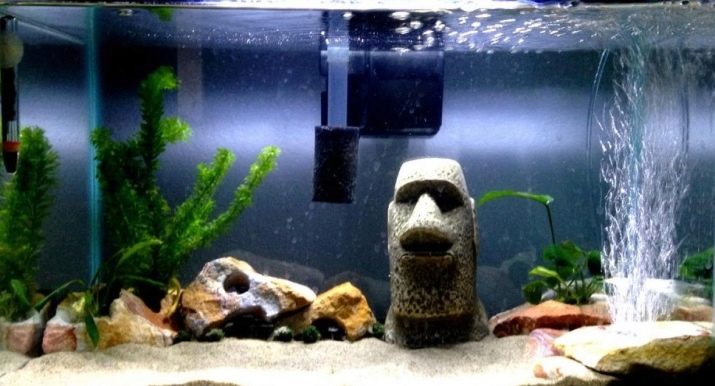
Natural
You can not invent anything at all with special equipment, but instead bring the conditions in the aquarium as close as possible to the conditions of a natural reservoir. The aerator would create the same waves, but this is a technique, and without technical devices, the oxygen level can be increased only by planting an additional amount of plants. Dense thickets with a relatively small number of inhabitants will help to do without even any aerators, but you must make sure that your pets are not suffering from a lack of vital gas.
Snails can serve as an indicator of the amount of the latter., which many experienced aquarists breed for this very purpose. Unlike fish, these not the most mobile creatures clearly demonstrate whether everything is in order with the oxygen level. They instinctively know that there should be more oxygen in the upper layers than near the bottom, and during the maturing oxygen starvation they try to move as high as possible - they climb onto the plants and the walls of the container. In a normally aerated reservoir, they would never do this, because their typical habitat is the bottom.
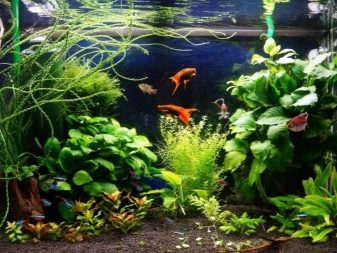

Artificial
For those who do not want to tinker with plants and snails, or are simply not sure that this will be enough, there is special equipment in the form of devices that provide aeration in one way or another. There are so many options for organizing the process that you can't figure it out right away, so we'll briefly consider all of them.
- Compressor. This mechanism, under pressure, pumps air bubbles under the water, causing the liquid to bubble characteristically. Such a device is quite effective, but its operation cannot be called silent, which is why many novice aquarists consider it possible to turn off the unit at least overnight. It is categorically not recommended to do this, since we have already mentioned above that plants also begin to consume oxygen in the dark, which means that very little of it remains for fish.
When choosing a compressor, you must either put up with the constant bubbling, or set the aquarium away from sleeping areas.

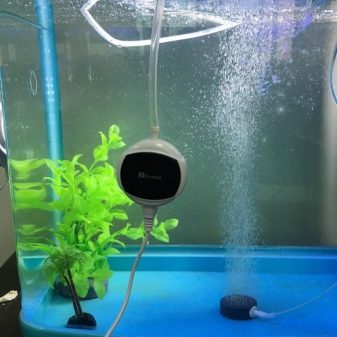
- Sprayers... Typically, such a device is an integral part of the compressor, with which it works in tandem, being its nozzle. It is necessary to install the sprayers in the ground - thanks to this, air bubbles are pumped to the very bottom and float to the surface for as long as possible. Due to this, the highest efficiency of gas-liquid dissolution is achieved. The connection of the nozzles to the compressor is carried out using hoses and connectors, it is reasonable to scatter them over the entire area of the aquarium in order to make the aeration as efficient as possible.



- Soil filter. This unit is an alternative to the compressor, since it provides a similar effect in a fundamentally different way. If the compressor pumps oxygen into the depths of the reservoir, then the filter constantly mixes the water flows, creating a current. Due to this, the upper layer, saturated with oxygen, goes to the bottom, and oxygen-poor water comes in its place, which greatly accelerates the aeration process.


- Water pump. This complex unit combines the principles of operation of both a compressor and a soil filter - it mixes water and pumps oxygen into it under pressure, passing it directly through the flow. The pump can be called "heavy artillery", it shows the highest efficiency, but at the same time its capacity should not be less than a third of the volume of the aquarium.
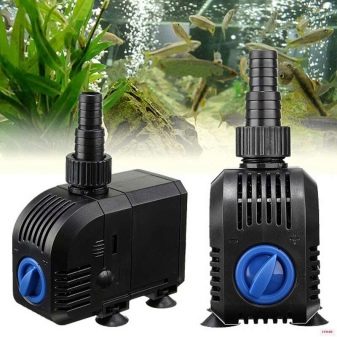

- Hydrogen peroxide. It is possible to organize aeration, and urgent, even without electricity - just add hydrogen peroxide to the aquarium. No matter how much you use this liquid, the dosage will always be calculated correctly, since this substance is harmless - in the aquarium it decomposes into the same water and oxygen that we need. Peroxide is usually used either to combat harmful algae growing in poor aeration, or for urgent resuscitation of fish after oxygen starvation.


- Oxygen tablets. This is another solution that allows you to quickly raise the oxygen level in an artificial reservoir without any electricity. Unlike hydrogen peroxide, this tool is considered not only a way of resuscitation, but also a solution to the problem when it is not possible to use an electrical device, for example, when transporting fish somewhere. Typically, one tablet contains 30 mg of oxygen. Considering that the norm is 5-6 mg per liter, one tablet is enough for 5-6 liters of water, in which there is no useful gas at all.


- Oxidizers... These are the simplest devices that work exclusively thanks to chemical processes, without the need for power supply. In fact, this is a special container into which the already mentioned hydrogen peroxide is poured and chemical catalysts are added, due to which the peroxide begins to decompose into water and oxygen even faster. A feature of the device is that it does not allow peroxide as such into the water, releasing only its decay products - some especially sensitive fish still do not like this substance.


- Hand compressor... Such a mechanism is an analogue of an electric compressor, but it works purely from the work of human hands. In fact, this is a hollow pear with two holes - one is located close to it and lets air in, a hose is attached to the other, thanks to which air will be pumped directly into the aquarium by squeezing the pear by hand. This is another method, often used in the transportation and sale of fish, which is especially popular, since the necessary device is made by "craftsmen" from scrap materials.


It should be noted that the effectiveness of aeration of the aquarium also depends on how much attention you pay to the correct functioning of your home ecosystem.
We have already talked about the benefits of plants (and their potential harm at night), but the influence of "unusual" factors does not end there. For example, too warm water is always poorer in oxygen than cool water. This is due to the interdependence of the ambient temperature and metabolism in any living organism - in warmth, all life processes occur faster, which means that more oxygen is consumed in the same amount of time. You can indirectly influence the degree of aeration by maintaining the correct temperature, although, of course, you should not get carried away with this method, otherwise your tropical pets will simply freeze.
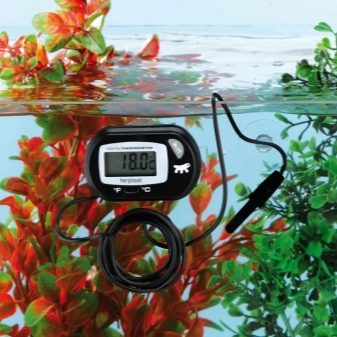

In addition, it is important to promptly clean the aquarium from the remains of old food and to carry out regular water changes in order to reduce its contamination with fish waste.
Above, we mentioned that beneficial aerobic bacteria are involved in the breakdown of the latter, which require air to function. The ideal conditions for the reproduction of these microorganisms, created in an unkempt aquarium, lead to the fact that the useful becomes harmful - the growing population begins to compete with your pets for vital gas and the question is who will win without outside interference.
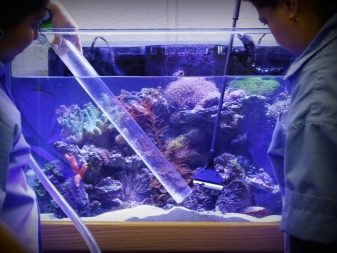

How often should it be turned on?
This question cannot be answered unequivocally, because it all depends on two factors: how much oxygen enters the aquarium without your participation and how much of this gas is required for the normal functioning of the ecosystem... It is difficult to calculate the consumption by a theoretical method, even approximately, because oxygen is consumed not only by every fish, but also by every plant in the dark and by every invisible aerobic bacterium. That's why Experienced aquarists make sure to measure the oxygen level in the aquarium water.
There are several ways to do this. We already mentioned above that you can identify the problem thanks to the behavior of specially bred aquarium snails, but there are more accurate methods - for this, you can buy a one-time test or a more complex measuring device at the pet store. If there are 5-6 mg of oxygen per liter of water, or the detected value differs insignificantly in either direction, you can be congratulated - your home ecosystem is currently functioning correctly and does not require outside intervention.
It is important to understand that not only a lack, but also an overabundance of oxygen in the water is harmful to fish. When there is too much gas, air capsules can form in the blood vessels of the fish, and then the excess gas can kill the pets.

For this reason, it is important to understand the main thing: although the same compressor must work constantly, it is necessary to constantly adjust its power, taking into account how conditions will change in the coming hours, constantly monitoring the dynamics of the oxygen level in the water.
For example, oxygen consumption inevitably increases at night, and you must consider this point. Unfortunately, there is no formula for calculating how much more intensive aeration should work at night - you can only determine this experimentally by observing the reaction of your aquarium. If you do not have the opportunity to keep the water temperature constantly at one stable level, then you will have to make a discount on heating the liquid as well.
Below you can watch a video review of ways to aerate water in an aquarium.








